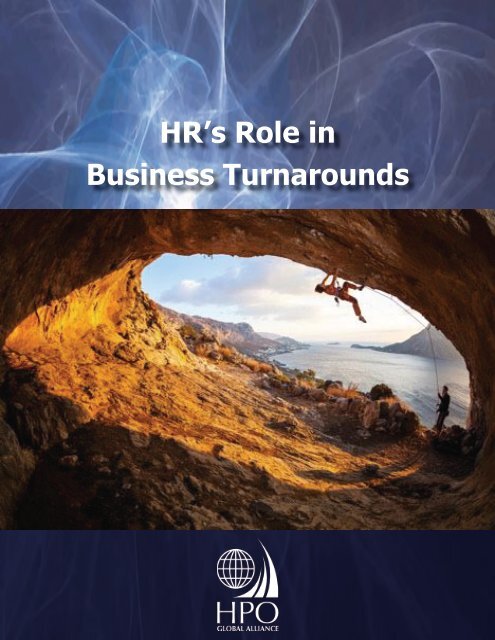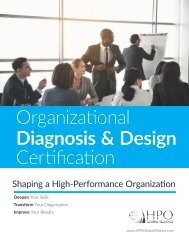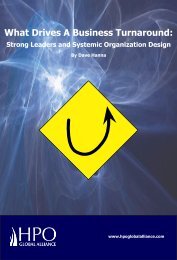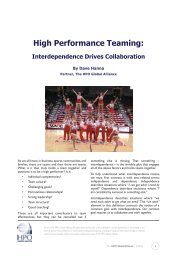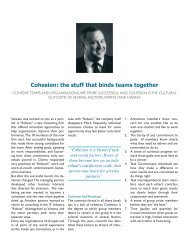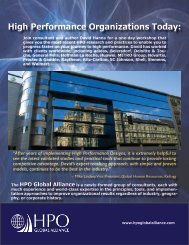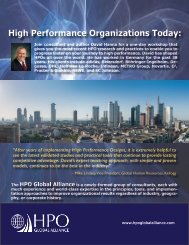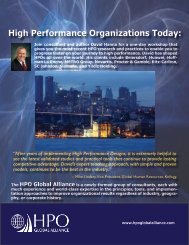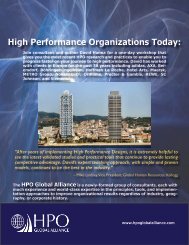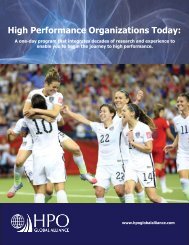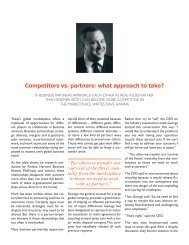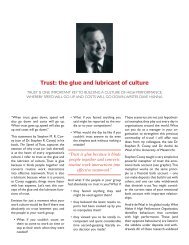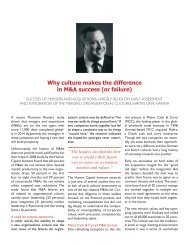HR's Role in Business Turnarounds
Create successful ePaper yourself
Turn your PDF publications into a flip-book with our unique Google optimized e-Paper software.
HR’s <strong>Role</strong> <strong>in</strong><br />
Bus<strong>in</strong>ess <strong>Turnarounds</strong><br />
The HPO Global Alliance ©2017<br />
1
HR’s <strong>Role</strong> <strong>in</strong> Bus<strong>in</strong>ess <strong>Turnarounds</strong><br />
Dave Hanna<br />
The HPO Global Alliance<br />
“Many bus<strong>in</strong>ess leaders today are challenged<br />
to turn around their bus<strong>in</strong>esses<br />
due to massive changes <strong>in</strong> the marketplace.<br />
<strong>Turnarounds</strong> seldom are accomplished by a<br />
brilliant <strong>in</strong>dividual act<strong>in</strong>g alone; they require<br />
the team<strong>in</strong>g of different resources and efficient,<br />
supportive organizational processes<br />
and systems. HR professionals should have<br />
the skills necessary to take the lead <strong>in</strong> gett<strong>in</strong>g<br />
people and systems better synced to<br />
produce a bus<strong>in</strong>ess turnaround.<br />
Here are six examples of leaders who navigated<br />
successful bus<strong>in</strong>ess turnarounds and a<br />
brief description <strong>in</strong> each case of what their<br />
HR managers did to add value to the effort.<br />
1. Communicate a clear vision and<br />
strategy: The president of a large European<br />
organization aimed to better align<br />
how country organizations collaborated<br />
<strong>in</strong> new market dynamics <strong>in</strong> Europe.<br />
The president kept gett<strong>in</strong>g feedback<br />
that associates <strong>in</strong> the different countries<br />
didn’t know what the strategic priorities<br />
were. This lack of clarity led to very<br />
diverse (and often counterproductive)<br />
actions that re<strong>in</strong>forced the status quo.<br />
Although the president had announced<br />
the strategic priorities <strong>in</strong> speeches, executive<br />
meet<strong>in</strong>gs, and memos over several<br />
months, everyone still operated by<br />
the old code of conduct. F<strong>in</strong>ally, his HR<br />
coach said to him, “People don’t pull out<br />
a memo to refresh their memory about<br />
what’s important. What they need is a<br />
short statement that they can hold <strong>in</strong><br />
their m<strong>in</strong>d’s eye as they work.” At the<br />
president’s request, the coach went<br />
through the various documents and produced<br />
a short three-paragraph strategy<br />
statement <strong>in</strong> the president’s own words.<br />
As this new document was distributed<br />
and discussed, the confusion about<br />
strategic priorities went away. For<br />
example, one general manager compla<strong>in</strong>ed<br />
that the European R&D organization<br />
wanted to <strong>in</strong>troduce a new<br />
product under a brand name that this<br />
manager’s market research <strong>in</strong>dicated<br />
was a very weak position vs. competition.<br />
“What can I do?” he asked.<br />
His HR coach asked, “Is there anyth<strong>in</strong>g <strong>in</strong><br />
the strategy that justifies your position?”<br />
The general manager replied, “Well<br />
there is that priority about stopp<strong>in</strong>g<br />
any profit hemorrhages. That’s it! What<br />
R&D is ask<strong>in</strong>g us to do is off strategy for<br />
our market.”<br />
The new product enjoyed a successful<br />
launch –under a different brand name–<br />
and is still a profit contributor many<br />
years later.<br />
2. Lead by example: Members of an<br />
executive team, <strong>in</strong> response to an<br />
economic recession, voluntarily suspended<br />
their own salaries at the same<br />
time they had to reduce employee<br />
wages to weather the storm. Associates<br />
<strong>in</strong> this company were impressed<br />
that their leaders were sacrific<strong>in</strong>g<br />
along with them <strong>in</strong> this tough period.<br />
Build<strong>in</strong>g on this goodwill and the clear<br />
message of the seriousness of their<br />
situation, the HR function organized<br />
workshops <strong>in</strong> all corners of the company<br />
to identify tangible ways to cut costs<br />
2
so that everyone’s normal wages could<br />
be re<strong>in</strong>stated as soon as possible. The<br />
bra<strong>in</strong>storm<strong>in</strong>g moved quickly to implementation<br />
and the company got back<br />
to normal faster than its competitors.<br />
3. Align processes and systems to fully<br />
support vision and strategy: Leaders<br />
at a premier agricultural products company<br />
have a simple, straightforward mission:<br />
“to produce (our) products and<br />
services which consistently achieve the<br />
quality and service expectations of our<br />
customers <strong>in</strong> a cost effective, environmentally<br />
responsible manner.” Two govern<strong>in</strong>g<br />
pr<strong>in</strong>ciples support this mission:<br />
• Don’t use force<br />
• Keep your commitments<br />
HR has taken the lead to shape an organizational<br />
<strong>in</strong>frastructure to align with<br />
the mission and govern<strong>in</strong>g pr<strong>in</strong>ciples:<br />
• One production l<strong>in</strong>e is shared as<br />
needed by two product groups<br />
(bulk product and f<strong>in</strong>ished product).<br />
• Individual goals and teamwork are<br />
focused on the key factors to fulfill<br />
the mission.<br />
• Every associate is personally responsible<br />
for gett<strong>in</strong>g the tra<strong>in</strong><strong>in</strong>g<br />
they need, schedul<strong>in</strong>g their time<br />
commitments, uphold<strong>in</strong>g performance<br />
standards, and contribut<strong>in</strong>g<br />
to fulfill<strong>in</strong>g the mission and govern<strong>in</strong>g<br />
pr<strong>in</strong>ciples.<br />
• Differences <strong>in</strong> values and work approaches<br />
are acceptable, provid<strong>in</strong>g<br />
those differences do not detract<br />
from fulfill<strong>in</strong>g the mission.<br />
• Associates exchange <strong>in</strong>formation<br />
freely with all stakeholders and<br />
help as needed to ensure everyone<br />
succeeds.<br />
• All associates live, speak, and endeavor<br />
to f<strong>in</strong>d the truth.<br />
This company’s “turnaround” has been<br />
to convert a successful start-up <strong>in</strong>to a<br />
high perform<strong>in</strong>g, rapidly-expand<strong>in</strong>g operation<br />
that has become the world’s<br />
lead<strong>in</strong>g food processor <strong>in</strong> its product<br />
category. Its <strong>in</strong>novative and productive<br />
work culture has transformed traditional<br />
“hired hands” <strong>in</strong> the farm<strong>in</strong>g<br />
<strong>in</strong>dustry <strong>in</strong>to loyal, skilled, and committed<br />
contributors to its success.<br />
More than 97 percent of the 4,000<br />
seasonal associates return each year<br />
despite the fact they are employed<br />
only four months out of the year.<br />
4. Connect emotionally with associates:<br />
The associates and leaders of a<br />
South African f<strong>in</strong>ancial services company<br />
collaborated to assist a recentlyhired<br />
associate who was experienc<strong>in</strong>g<br />
several crises simultaneously. This associate’s<br />
husband died suddenly; she was<br />
fac<strong>in</strong>g the likelihood of default<strong>in</strong>g on her<br />
home mortgage; and she had just begun<br />
treatment for newly-discovered cancer.<br />
HR learned of this woman’s desperate<br />
situation and organized contributions<br />
from the company and voluntary contributions<br />
from associates. HR also managed<br />
a flexible work schedule tailored<br />
to her unique needs. This woman has<br />
emerged successfully from this emotional<br />
pit and the bond between her<br />
and the company couldn’t be stronger.<br />
The HPO Global Alliance ©2017<br />
3
5. Overcome obstacles: A European<br />
producer of mach<strong>in</strong>e tools, laser technology,<br />
and electronics was fac<strong>in</strong>g a 40<br />
percent drop <strong>in</strong> sales dur<strong>in</strong>g the 2008<br />
recession. Company leaders were<br />
firm that no associates should be laid<br />
off. But how else could this company<br />
make it through this economic hardship?<br />
The HR function managed a plan<br />
to reduce work hours for all associates.<br />
Associates responded very positively<br />
to the company preserv<strong>in</strong>g their<br />
jobs when so many others <strong>in</strong> their<br />
region were be<strong>in</strong>g laid off. “Tighten<strong>in</strong>g<br />
our belts is a much better alternative<br />
than los<strong>in</strong>g our jobs,” one associate said.<br />
The silver l<strong>in</strong><strong>in</strong>g <strong>in</strong> this dark cloud was<br />
revealed when the recession ended and<br />
the company could immediately go back<br />
to full production. Other companies,<br />
who had laid off experienced workers,<br />
now had to hire new employees<br />
and wait for them to get up to speed.<br />
This company’s sales <strong>in</strong>creased 50 percent<br />
<strong>in</strong> the first year of its recovery<br />
6. Celebrate success and <strong>in</strong>spire cont<strong>in</strong>uous<br />
improvement: A lead<strong>in</strong>g pharmaceutical<br />
company, led jo<strong>in</strong>tly by its president<br />
and HR leaders, <strong>in</strong>vested heavily <strong>in</strong><br />
chang<strong>in</strong>g the m<strong>in</strong>dset of its top leadership<br />
echelons from be<strong>in</strong>g “good managers”<br />
to be<strong>in</strong>g “effective leaders.” Twelve<br />
months later under the new leadership<br />
focus, a record sales year was celebrated.<br />
The next year, the company went even<br />
further, implement<strong>in</strong>g a process <strong>in</strong> which<br />
each of its top 250 managers aligned<br />
their key priorities with specific po<strong>in</strong>ts<br />
<strong>in</strong> the company mission and with priorities<br />
of their functional colleagues and<br />
their cross-functional team colleagues,<br />
and with their boss. This tight alignment<br />
with the mission delivered yet another<br />
record sales year and a growth rate<br />
four times as fast as the global market.<br />
Essential HR Competencies That<br />
Drive <strong>Turnarounds</strong><br />
Drawn from these case examples, here<br />
are four essential competencies for HR<br />
professionals who coach and consult with<br />
bus<strong>in</strong>ess leaders who seek a turnaround:<br />
• The Competency to Diagnose: the<br />
ability to see what others may miss <strong>in</strong><br />
how the organization is really operat<strong>in</strong>g<br />
and to identify the multiple cause and effect<br />
streams that affect the bottom l<strong>in</strong>e.<br />
• The Competency to Apply Organization<br />
Theory: an understand<strong>in</strong>g<br />
of the theories, research f<strong>in</strong>d<strong>in</strong>gs, and<br />
practical experience that can predict<br />
how people will work together <strong>in</strong> a<br />
variety of situations and the ability to<br />
apply this understand<strong>in</strong>g <strong>in</strong> a practical<br />
way that delivers improved results.<br />
• The Competency to Design High<br />
Performance Organizations: know<strong>in</strong>g<br />
the results of past experiments with<br />
organizational form <strong>in</strong> motivat<strong>in</strong>g and<br />
regulat<strong>in</strong>g work <strong>in</strong>teractions so that<br />
reshap<strong>in</strong>g strategy, processes, systems,<br />
and structures produces better results.<br />
• The Competency to Coach Bus<strong>in</strong>ess<br />
Leaders <strong>in</strong> the Dynamics of a Turnaround:<br />
know<strong>in</strong>g the organizational<br />
dynamics around change, the emotions<br />
that change br<strong>in</strong>gs out <strong>in</strong> people, and<br />
bus<strong>in</strong>ess leaders’ personalities so that<br />
your advice, coach<strong>in</strong>g, and feedback will<br />
help make the turnaround a success.<br />
Review the follow<strong>in</strong>g table to glean a few<br />
more ideas of how you might add value<br />
to your leaders’ turnaround attempts.<br />
4
WHAT BUSINESS LEADERS DO<br />
1. Communicate a clear vision and<br />
strategy to pursue<br />
WHAT HR PROFESSIONALS DO<br />
• Monitor <strong>in</strong>dustry, customers, and competitors to be able<br />
to discuss <strong>in</strong>telligently what future opportunities could be<br />
explored<br />
• Work with leaders to articulate the vision and strategy<br />
• Coach leaders on ways to build understand<strong>in</strong>g and commitment<br />
2. Lead by example • Build leaders’ awareness of how stakeholders view the leaders’<br />
behaviors<br />
3. Align organizational systems to<br />
fulfill the vision and strategy<br />
4. Connect emotionally with<br />
others<br />
• Po<strong>in</strong>t out situations where lead<strong>in</strong>g by example is critical<br />
• Provide feedback on how well leaders “walk the talk”<br />
• Be up to date on organization design pr<strong>in</strong>ciples and available<br />
tools that may be used to fit everyth<strong>in</strong>g together<br />
• Diagnose the whole system’s dynamics and root causes to<br />
understand precisely what helps or h<strong>in</strong>ders the goals<br />
• Facilitate work sessions to align processes, structures,<br />
people development systems, and rewards with vision and<br />
strategy<br />
• Gather feedback on how th<strong>in</strong>gs are go<strong>in</strong>g via op<strong>in</strong>ion surveys<br />
and discussion groups and share results with leaders<br />
• Organize discussion forums with customers, suppliers, employees,<br />
etc. so that leaders get first-hand feedback on how<br />
th<strong>in</strong>gs are go<strong>in</strong>g<br />
• Po<strong>in</strong>t out critical <strong>in</strong>cidents and coach leaders how to connect<br />
emotionally with others for positive outcomes<br />
5. Overcome obstacles • Coach leaders to understand first the realities and their<br />
root causes of the situation<br />
6. Celebrate success and <strong>in</strong>spire<br />
cont<strong>in</strong>uous improvement<br />
• Facilitate the creation of an implementation plan<br />
• Monitor the implementation until the turnaround is successful.<br />
• Coach the leaders not to rest on their laurels, but to renew<br />
the entire process (1-6) as the evolv<strong>in</strong>g market dictates.<br />
• As a facilitator, constantly ask groups, “What have we<br />
learned? “ and “How can we improve?”<br />
• Stay <strong>in</strong> touch with what really motivates <strong>in</strong>dividuals and<br />
groups and help the leaders connect these factors with cont<strong>in</strong>uous<br />
improvement <strong>in</strong>itiatives<br />
The HPO Global Alliance ©2017<br />
5


